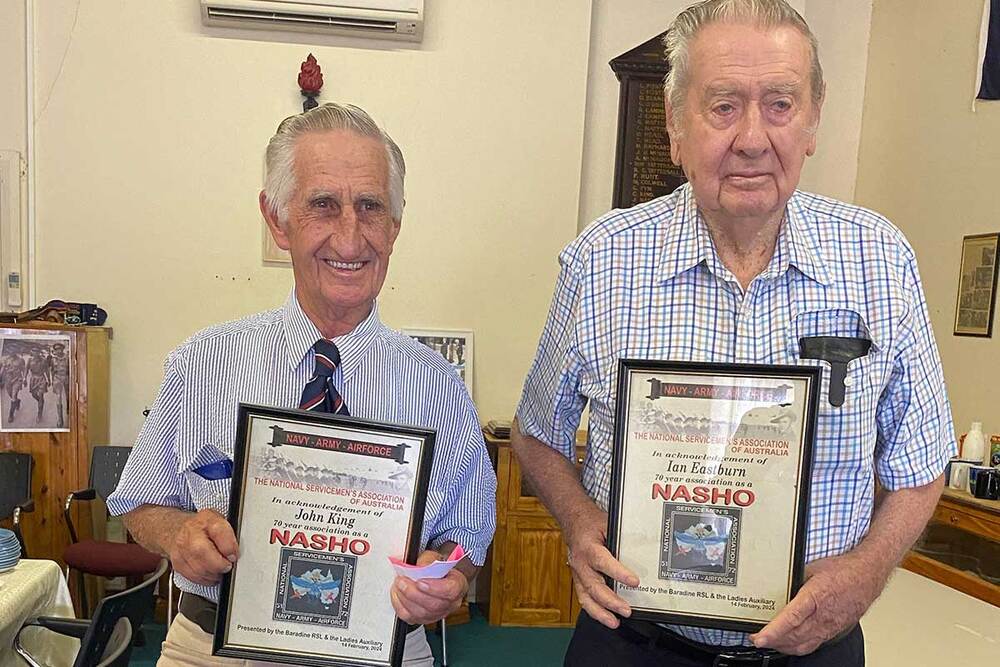Baradine remembers the ‘nashos’
Liz Cutts
05 March 2024, 6:40 AM
 18-year-old John King (circled) with fellow servicemen and instructional staff of the nineteenth platoon.
18-year-old John King (circled) with fellow servicemen and instructional staff of the nineteenth platoon.A tribute has been paid to those who served our nation through compulsory military training following the Second World War.
Members of the Baradine RSL Woman’s Auxiliary held an afternoon tea on Wednesday 14 February to mark National Servicemen’s Day and to acknowledge the contribution of the servicemen known as the ‘nashos’.
The commemoration marks 52 years since the last intake of men were conscripted to join the National Service Scheme before it was abolished by the Whitlam Labor government in 1972.
Between 1951 and 1972, almost 300,000 young men were called into two separate schemes for compulsory training in the navy, army, and air force. It was the height of the Cold War, when Australia feared for its defence capability in the face of Communist aggression and a time when memories of the war in the Pacific, Japanese attacks on Australia and the commencement of the Korean War in 1950 were fresh in Australia’s national consciousness.
It is just over seventy years since Baradine residents, Ian Eastburn and John King were called up to do their national service training.
Ian Eastburn has nothing but praise for the time he spent as a ‘nasho’ when he was enlisted in 1952.

PHOTO: John King and Ian Eastburn received certificates of appreciation for being ‘nasho’s
“I was nineteen years old and trained at the RAAF Schofields aerodrome near Blacktown, Sydney,” said Ian. “Us blokes from the bush always thought we were tougher than the city blokes, but they could do everything as well as we could. The training was pretty hard, and you had to pay attention at all times.
“We got on the train at Gwabegar at 10am and got to Sydney at six am the next day. Sam Stackpoole from Pilliga was in my intake, and we used to play up a bit.
“I was allocated to Airforce aerodrome defence as a Bren gunner; the training was basically the same as the army. It was a good experience all round and a good thing to do.
“The army recruits had to do three months training and then go back for three weeks every year for refresher training and be on standby for eight years. The air force did six months training and were reserves for five and a half years.
“At the end of the training I tried to join up permanently, but the Korean peace talks were underway, and we were told they did not want any more recruits.”
John King was eighteen years old when he was enlisted as a nasho in February 1954.
“I was in the nineteenth platoon E company, thirteenth battalion at the Ingleburn army camp,” said John.
“Local blokes Fred and Jim Keegan were in the intake just before mine and Sammy Ryan was in the same hut as me. Now there are only four of us left from that intake that I know of from the whole of the Baradine, Gulargambone, Coonamble and Dubbo area.
“The mateship and respect at the training was wonderful; it was a great learning period and I think the government should have kept it going. I was there when Queen Elizabeth and the Duke of Edinburgh visited Australia after the coronation; I have great memories of it all.
“We had a great time; our biggest headache was getting back to camp by 11.59pm otherwise we were AWL! But it was an easy life because of the routine. When I finished my training, I stayed in for a further two weeks to prepare for the training of the next intake. It was a lot better than dealing with maggoty sheep!
“As far as I am concerned it was one of the best times of my life.”



